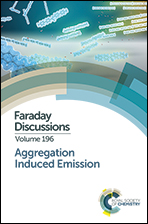AIE phenomena of a cyanostilbene derivative as a probe of molecular assembly processes†
Abstract
The initial processes of the crystallization of a solute molecule, 1-cyano-trans-1,2-bis-(4′-methylbiphenyl)-ethylene (CN-MBE) in binary solution (water and acetone), were investigated by means of fluorescence spectroscopy as well as scanning electron microscopy (SEM). With an increase in the volume fraction (Vw) of the poor solvent (water) in the solution, a drastic change in the fluorescence spectra and intensity of CN-MBE was observed. This change was attributed to aggregation induced emission (AIE). By analyzing the evolution of AIE by multivariate curve resolution-alternating least squares (MCR-ALS), it was revealed that four main species appeared in the solution depending on the Vw values. On the basis of molecular exciton theory, we assigned these four emissive states to the monomer, H-dimer, J-dimer, and H-aggregates. Interestingly, the J-dimer state was observed only in a Vw range of 40% to 50%, just before the formation of the aggregate. This result suggests that the J-dimer plays an important role as the precursor for larger aggregates leading to crystal formation. By integrating the present results with previous work on the crystallization of CN-MBA through solvent evaporation, we discussed the dynamics of the crystallization from the viewpoint of the sequence of molecular species appearing in the aggregation in solution.
- This article is part of the themed collection: Aggregation Induced Emission


 Please wait while we load your content...
Please wait while we load your content...